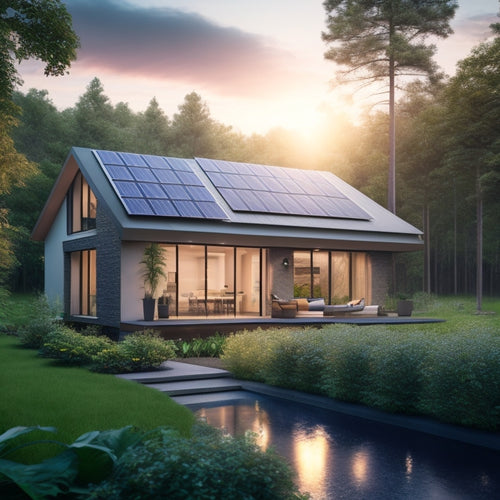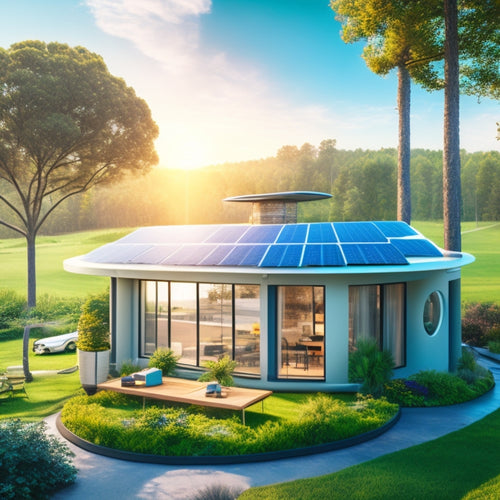
Drought-Resistant Gardens Thrive With Recycled Household Water
Share
By utilizing and reusing recycled household water, you can create a thriving drought-resistant garden that not only conserves potable water but also reduces your water bills. Effective greywater utilization involves designing a water-efficient environment, selecting drought-tolerant plant species, and implementing a greywater recycling system. This system requires a collection system, treatment and filtration, and regular maintenance. By exploring these key components, you'll be well on your way to creating a sustainable and resilient garden that flourishes with minimal water usage, and there's more to uncover about optimizing your greywater system for maximum efficiency.
Key Takeaways
- Reusing greywater from sinks, showers, and washing machines reduces potable water usage for irrigation, helping drought-resistant gardens thrive.
- Effective greywater irrigation methods, like drip and micro-irrigation, minimize evaporation and ensure consistent water supply, especially during droughts.
- Implementing a greywater recycling system with proper treatment and filtration ensures safe irrigation water for plants, reducing water bills and environmental impact.
- Selecting drought-tolerant plant species, such as native plants and succulents, and grouping them by water needs enhances irrigation effectiveness and garden resilience.
- Regular monitoring and maintenance of the greywater system, including filter cleaning and water quality tests, ensures a healthy and efficient system for sustainable irrigation.
Harnessing Greywater for Irrigation
Every gallon of greywater you reuse is one less gallon of potable water redirected from drinking and cooking. By utilizing greywater for irrigation, you're not only conserving this valuable resource but also reducing your water bill.
Implementing renewable energy solutions in your garden can further enhance your water conservation efforts. Greywater benefits your garden by providing a consistent water supply, even during droughts, much like how solar panels on fleet vehicles reduce reliance on fossil fuels.
You can use greywater for various irrigation methods, such as drip irrigation or micro-irrigation, which deliver water directly to the roots of plants. This approach minimizes evaporation and runoff, ensuring your plants receive the water they need.
Designing a Water-Efficient Landscape
When designing a water-efficient environment, you'll need to take into account three vital factors: the type of soil you're working with, the irrigation system you'll use, and the plants you'll select.
Soil type affects how water is absorbed and retained, so it's important to choose plants and irrigation systems that work in harmony with your soil.
In addition, incorporating sustainable practices, such as renewable energy sources, can reduce your carbon footprint and enhance the eco-friendliness of your environment.
Soil Type Matters
How can you create a water-efficient environment if your soil is working against you? Understanding your soil composition is essential in designing a water-efficient setting.
Regular cleaning practices, such as those applied to electrical connections, can also be applied to soil to prevent dirt and debris buildup, enhancing water efficiency.
You'll need to take into account drainage techniques to prevent waterlogging, which can be achieved through soil amendments like organic matter. This will also improve nutrient retention, pH balance, and microbial activity.
Compaction effects can be mitigated by incorporating aerating materials, ensuring moisture retention and reducing erosion control issues.
Efficient Irrigation Systems
By integrating efficient irrigation systems into your garden design, you can greatly reduce water waste and create a thriving environment that requires minimal maintenance.
To achieve this, consider the following strategies:
-
Use drip irrigation systems, which deliver water directly to the roots of plants, reducing evaporation and runoff. This approach is particularly effective when paired with solar-powered energy solutions Fast Charging Infrastructure, which can power irrigation systems and reduce reliance on traditional energy sources.
-
Implement rainwater harvesting systems to collect and store rainwater for later use, a method that also supports corporate sustainability initiatives.
-
Install moisture sensors to monitor soil moisture levels and adjust irrigation schedules accordingly.
-
Employ weather-based irrigation controllers that adjust watering schedules based on weather data.
-
Incorporate mulch and groundcovers to reduce soil evaporation and retain moisture.
Smart Plant Selection
In designing a water-efficient environment, selecting the right plants is crucial for minimizing water consumption and creating a thriving drought-resistant garden.
You'll want to choose native plants that are naturally adapted to your region's climate, reducing the need for excessive watering. Incorporate seasonal blooms to add color and interest while conserving water.
Companion planting can also enhance drought resilience by providing shade, improving soil health, and deterring pests. Additionally, implementing energy-efficient measures, such as evaluating fleet energy needs, can also contribute to a sustainable garden.
Don't forget to take into account soil amendments and microclimates management to optimize plant growth. Choose water-efficient crops with high plant hardiness to guarantee they can thrive in challenging conditions.
Greywater Recycling System Basics
Your garden's water efficiency can be considerably enhanced by incorporating a greywater recycling system, which collects and treats wastewater generated from sinks, showers, and washing machines for irrigation purposes.
This system allows you to conserve potable water and reduce your water bill. To set up a greywater recycling system, you'll need to take into account the following components:
-
Greywater regulations: Familiarize yourself with local laws and guidelines governing greywater reuse to guarantee compliance.
-
System components: Identify the necessary parts, including pipes, fittings, and storage tanks, to design an efficient system.
-
Water treatment: Determine the level of treatment required to make the greywater suitable for irrigation.
-
Distribution system: Plan how you'll distribute the treated greywater to your plants.
-
Maintenance schedule: Establish a regular maintenance routine to keep your system functioning properly.
Selecting Drought-Tolerant Plant Species
When selecting drought-tolerant plant species for your garden, you'll need to evaluate their individual water requirements, as some plants can thrive with minimal moisture while others need consistent hydration.
You'll also want to assess soil moisture levels, as certain plants are adapted to survive in dry soil conditions.
Additionally, choose plants that are well-suited to your local climate, as they'll be more resistant to drought and require less maintenance.
Plant Water Requirements
By designing your garden with drought-tolerant plant species, you'll greatly reduce water consumption and create a resilient outdoor space.
To guarantee peak plant growth, consider the specific water requirements of each species. Some plants thrive with minimal watering, while others need more frequent irrigation.
- Assess the plant's native habitat to determine its natural water needs.
- Group plants by water requirements to enhance irrigation techniques.
- Incorporate seasonal planting to accommodate changing water sources and moisture retention.
- Implement nutrient management strategies to promote healthy plant growth.
- Consider urban gardening principles to maintain ecosystem balance in your drought-resistant garden.
Soil Moisture Levels
Soil's water-holding capacity plays an essential role in selecting drought-tolerant plant species for your garden.
You'll want to choose plants that thrive in soil with low moisture retention, as they'll be more resilient to drought.
Soil moisture levels directly impact plant water requirements, so it's important to understand your soil type.
Sandy soils, for instance, drain quickly, while clay soils retain moisture longer.
You can amend your soil to improve its moisture retention by adding organic matter like compost or mulch.
This will help your plants survive with minimal watering.
When selecting plants, look for those adapted to your local soil type and moisture levels.
Adaptation to Climate
As you steer through the process of creating a drought-resistant garden, adapting to your local climate becomes essential in selecting the right plant species.
You'll want to choose plants that are naturally resilient to drought and can thrive in your region's specific climate conditions. This guarantees climate resilience and promotes sustainable practices in your garden.
Consider the following factors when selecting plant species:
-
Heat tolerance: Choose plants that can withstand high temperatures and remain healthy.
-
Water efficiency: Select plants that require minimal watering or can survive with recycled household water.
-
Soil adaptability: Pick plants that can thrive in your local soil type, whether it's sandy, clay, or loamy.
-
Native species: Opt for plants native to your region, as they're naturally adapted to the local climate.
-
Drought-tolerant varieties: Look for plant varieties bred specifically for drought resistance, such as succulents or cacti.
Creating a Greywater Collection System
Your greywater collection system starts with identifying greywater sources in your home, such as sinks, showers, and washing machines, which can supply a significant amount of water for irrigation.
You'll need to determine the flow rate and volume of greywater generated by each source to design an effective collection system.
Key system components include pipes, valves, and a storage tank to hold the collected water.
You can use collection methods like gravity-fed systems or pumps to direct the greywater to your storage tank.
Consider factors like pipe material, slope, and sizing to guarantee a smooth flow of water.
Implementing a Water-Saving Strategy
Implementing a water-saving strategy is essential to maximize the efficiency of your drought-resistant garden. By adopting sustainable practices, you'll conserve this precious resource and guarantee your garden thrives.
To get started:
- Install rain sensors and smart irrigation controllers to optimize water distribution.
- Mulch around plants to reduce evapotranspiration and retain moisture.
- Use drip irrigation systems, which deliver water directly to roots, reducing waste.
- Choose drought-tolerant plants and group them by water requirements to minimize overwatering.
- Monitor soil moisture levels to avoid unnecessary watering, promoting water conservation in your garden.
Greywater Treatment and Filtration
Greywater, the wastewater generated from sinks, showers, and washing machines, can be a beneficial resource for your drought-resistant garden.
To verify greywater is safe for your plants, it's vital to treat and filter it properly. You'll need to implement effective filtration methods to remove contaminants and pathogens. Treatment standards vary by region, so check with your local authorities to determine the requirements.
A well-designed greywater system will include a pre-treatment stage to remove large particles, followed by a biological or chemical treatment process. Finally, the water will pass through a filtration stage to remove any remaining impurities.
Maintaining a Healthy Greywater System
Regular monitoring and maintenance are essential to guaranteeing your greywater system operates efficiently and effectively.
You'll want to check your system regularly to prevent clogs, backups, and other issues that can render it useless.
To keep your greywater system in top shape, remember to:
- Inspect your pipes and fittings for signs of wear or damage
- Check your filters and clean or replace them as needed
- Monitor your water flow rates and adjust your system accordingly
- Perform regular water quality tests to guarantee your greywater is safe for irrigation
- Keep your system well-ventilated to prevent the buildup of odors and gases
Frequently Asked Questions
Can I Use Greywater for Fruit and Vegetable Gardens?
You can use greywater for fruit and vegetable gardens, but guarantee proper treatment and distribution to avoid contamination risks, as greywater benefits fruit health by providing essential nutrients, but improper use can compromise food safety.
Can I Connect Greywater Systems to Existing Plumbing?
You can connect greywater systems to existing plumbing, like the Arizona home that retrofitted its laundry-to-landscape system, but be aware of local greywater regulations and necessary plumbing modifications, ensuring a seamless, water-conserving setup.
Do Greywater Systems Require Frequent Maintenance Checks?
You'll need to perform regular maintenance checks to guarantee your greywater system's efficiency, typically every 1-3 months, to prevent clogs, corrosion, and backups, which can negatively impact system efficiency and overall performance.
Will Greywater Irrigation Systems Attract Pests and Rodents?
You'll be relieved to know that, with proper design and installation, greywater irrigation systems won't become a pest magnet, as long as you prioritize pest management and rodent prevention measures, like using rodent-resistant pipes and regular inspections.
Can Greywater Be Stored for Extended Periods of Time?
You can store greywater for extended periods if you implement proper greywater storage and water treatment systems, ensuring it remains safe and pathogen-free, but be aware that prolonged storage can lead to anaerobic conditions and odors.
Related Posts
-

3 Best Eco-Grants for Home Energy Upgrades
You're eligible for various eco-grants that can help you cut down on energy bills and reduce your carbon footprint by...
-

Why EVs Inspire Earth-Conscious Home Design Choices
As you shift to an electric vehicle, you're not just switching to a greener ride, you're igniting a broader commitmen...
-

Gamify Your Home's Energy Generation and Savings
You're taking the next step in optimizing your home's energy generation and savings by utilizing the power of gamific...


